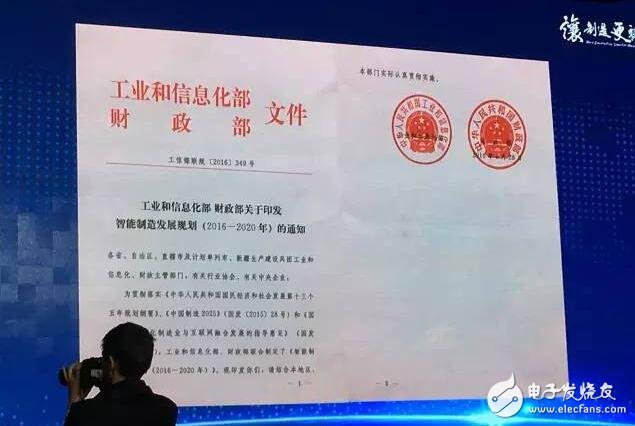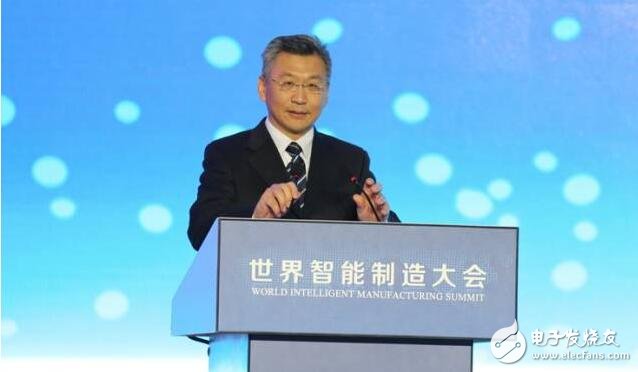On the morning of December 7, the World Smart Manufacturing Cooperation Development Summit was officially opened in Nanjing, Jiangsu. The Ministry of Industry and Information Technology and the Ministry of Finance jointly issued the "Intelligent Manufacturing Development Plan (2016-2020)" as a programmatic document guiding the development of national intelligent manufacturing during the "13th Five-Year Plan" period. Li Dong, Director of the Equipment Industry Department of the Ministry of Industry and Information Technology, disclosed the guiding ideology and main contents of the "Planning" at the meeting, and proposed the "two-step" strategy and key tasks for promoting China's smart manufacturing implementation. The "Planning" proposes to promote the "two-step" strategy for smart manufacturing implementation by 2025: the first step is to significantly enhance the foundation and support capacity of intelligent manufacturing development by 2020, and the digital manufacturing of traditional manufacturing key areas is basically conditional. Significant progress has been made in the intelligent transformation of key industries; in the second step, by 2025, the intelligent manufacturing support system has been basically established, and key industries have initially achieved intelligent transformation. The Plan also proposes ten key tasks: First, accelerate the development of intelligent manufacturing equipment, overcome key technical equipment, improve quality and reliability, and promote integrated applications in key areas; The second is to strengthen key common technology innovations, break through a number of key common technologies, and lay out and accumulate a batch of core intellectual property rights; The third is to build an intelligent manufacturing standard system, carry out standard research and test verification, and accelerate the standardization, revision and popularization of applications; The fourth is to build the foundation of industrial Internet, develop new industrial network equipment and systems, information security software and hardware products, build a test verification platform, and establish a sound risk assessment, inspection and information sharing mechanism; The fifth is to increase the pilot demonstration and promotion of smart manufacturing, carry out pilot demonstrations of new modes of intelligent manufacturing , select smart manufacturing benchmark enterprises, continuously summarize experiences and models, and transplant and promote in relevant industries; The sixth is to promote the intelligent transformation of key areas, pilot the construction of digital workshops/smart factories in the ten key areas of “Made in China 2025â€, and promote the application of digital technology, system integration technology and intelligent manufacturing equipment in traditional manufacturing industries; The seventh is to promote the intelligent transformation of small and medium-sized enterprises, guide small and medium-sized enterprises to promote automation transformation, and build a cloud manufacturing platform and service platform; Eighth is to cultivate an intelligent manufacturing ecosystem, accelerate the cultivation of a number of system solution providers, vigorously develop leading enterprise groups, and make a number of “specialized and special†supporting enterprises; Nine is to promote the coordinated development of regional intelligent manufacturing, promote the construction of intelligent manufacturing equipment industry clusters, and strengthen the coordination of intelligent manufacturing resources between regions based on the Internet; The tenth is to build a team of intelligent manufacturing talents, improve the personnel training mechanism, strengthen the training of intelligent manufacturing talents, build a smart manufacturing training base, and build a multi-level talent team. Xin Guobin, deputy minister of the Ministry of Industry and Information Technology, said at the meeting that China's manufacturing industry is growing rapidly and became the largest manufacturing country in 2015. However, it still has a large gap with other advanced countries in terms of brand building and innovation capabilities, at least not strong. It is a bottleneck that needs to be solved urgently. At present, the domestic economy is declining and investment growth is slowing down. It is necessary to promote smart manufacturing as a new driving force for cultivating manufacturing. Xin Guobin said that at present, there are five new smart manufacturing models, such as discrete, process-based smart factories and remote operation and maintenance. Many enterprises in China have tasted the sweetness of smart manufacturing after such transformation and upgrading. Shandong Red Cross Group's annual profit margin rose from 2.8% to 27%. Promoting the construction of intelligent manufacturing alliances and promoting joint innovation, Nanjing Sino-German Manufacturing Research Institute and other institutions have become the main training places for intelligent manufacturing. The training institute of cooperation between Phoenix and Tongji University has more than 3,000 people receiving various trainings each year. He proposed: "Towards the future, the manufacturing industries in the world still have strong complementarities. China hopes to further strengthen cooperation with countries around the world in deepening exchanges, expanding key areas, strengthening standardization, conducting pilot and demonstration experience exchanges, and strengthening personnel training exchanges. Contact to jointly promote the development of manufacturing."
1.ANTENK Wire to Board connectors are avialable in different terminations and sizes intended for use on a variety of applications. These connectors provide power and signal with different body styles, termination options, and centerlines. To find the wire to board set required, click on the appropriate sub section below.
2.Our products are widely used in electronic equipments,such as monitors ,electronic instruments,computer motherboards,program-controlled switchboards,LED,digital cameras,MP4 players,a variety of removable storage disks,cordless telephones,walkie-talkies,mobile phones,digital home appliances and electronic toys,high-speed train,aviation,communication station,Military and so on
Antenk Wire To Board Connectors Ranges:
Power Wire to Board
Wire to Board Connectors Information Wire To Board Connectors,Wire Harness,Pcb Wire To Board Connector,Pin Wire To Board Connector,IDC Wire to Board,Locking Wire to Board,Latching Wire to Board,Fine Pitch Wire to Board ShenZhen Antenk Electronics Co,Ltd , https://www.antenkwire.com

IDC Wire to Board
Locking Wire to Board
Latching Wire to Board
Fine Pitch Wire to Board
Description
Wire-to-board connectors are used to interconnect printed circuit boards (PCBs) by using connectors attached to wires.
Specifications
Specifications for a wire to board connector include the following.
Wire-entry angle - There are three wire-entry angle styles: vertical, right-angle, and bottom-entry.
Wire size - Wire size is usually measured in American wire gauge (AWG), a standard for non-ferrous wire conductor sizes. The term "gauge" refers to the wire`s diameter. The higher the gauge number, the smaller the diameter and the thinner the wire.
Circuits or positions - With wire to board connectors, the number of circuits or positions may range from 1 to 120.
Pitch or center spacing - Pitch or center spacing is measured in millimeters (mm) or inches.
Lock to mating style - There are three basic lock-to-mating styles: positive, friction, and friction ramp.
Maximum current - The maximum current or current-carrying capacity is measured in amperes (A) and ranges from 1.0 A to 50. A.
Termination Methods
Crimp is the physical compression of a contact wire around a conductor to make an electrical and mechanical connection. Insulation displacement connectors (IDC) slice through the cable insulation to make a connection. Choices for termination method also include cage clamp, screw, tabs, and solder cups.
PCB Mounting Styles
With wire to board connectors, there are four choices for PCB mounting.
Through-hole technology (THT) mounts components on a PCB by inserting component leads through holes in the board and then soldering the leads in place on the opposite side of the board.
Surface mount technology (SMT) adds components to a PCB by soldering component leads or terminals to the top surface of the board. SMT components have a flat surface that is soldered to a flat pad on the face of the PCB. Typically, the PCB pad is coated with a paste-like formulation of solder and flux.
Press-fit and compression-style Board To Board Connectors are also commonly available.Wire to Board Connectors Information
Standards
Wire-to-board connectors carry approvals from various national and international organizations. In North America, they often bear marks from Underwriters Laboratories (UL) and/or the Canadian Standards Association (CSA).
A wire to board connector for the European marketplace should comply with the Restriction of Hazardous Substances (RoHS) and Waste Electrical and Electronic Equipment (WEEE) directives from the European Union (EU). Wire-to-board connectors that comply with other requirements are also available.
BS 9526 N0001 - Specification for multi-contact edge socket electrical connectors.
September 20, 2024